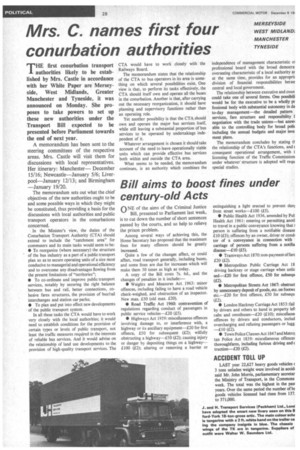Mrs. C. names first four conurbation authorities
Page 30

If you've noticed an error in this article please click here to report it so we can fix it.
THE first conurbation transport authorities likely to be established by Mrs. Castle in accordance with her White Paper are Merseyside, West Midlands, Greater Manchester and Tyneside, it was announced on Monday. She proposes to take powers to set up these new authorities under the Transport Bill expected to be presented before Parliament towards the end of next year.
A memorandum has been sent to the steering committees of the respective areas. Mrs. Castle will visit them for discussions with local representatives. Her itinerary: Manchester— December 15/16; Newcastle—January 5/6; Liverpool—January 12/13; and Birmingham —January 19/20.
The memorandum sets out what the chief objectives of the new authorities ought to be and some possible ways in which they might be constituted, thus providing a basis for the discussions with local authorities and public transport operators in the conurbations concerned.
In the Minister's view, the duties of the Conurbation Transport Authority (CTA) should extend to include the "catchment area" for commuters and its main tasks would seem to be: • To reorganize (where necessary) the structure of the bus industry as a part of a public transport plan so as to secure operating units of a size. most conducive to managerial and operational efficiency and to overcome any disadvantages flowing from the present limitations of "territories"; • To co-ordinate and improve public transport services, notably by securing the right balance between bus and rail, better connections, cohesive fares structures, the provision of bus/rail interchanges and station car parks; • To plan and put into effect new developments of the public transport system.
In all these tasks the CTA would have to work very closely with the local authorities; it would need to establish conditions for the provision of certain types or levels of public transport, not least the traffic measures required in the interests of reliable bus services. And it would advise on the relationship of land use developments to the. provision of high-quality transport services. The CTA would have to work closely with the Railways Board.
The memorandum states that the relationship of the CTA to bus operators in its area is something on which several possibilities exist. One view is that, to perform its tasks effectively, the CTA should itself own and operate all the buses in the conurbation. Another is that, after carrying out the necessary reorganization, it should have planning and supervisory functions rather than an operating role.
Yet another possibility is that the CTA should own and operate the major bus services itself, while still leaving a substantial proportion of bus services to be operated by undertakings independent of it.
Whatever arrangement is chosen it should take account of the need to leave operationally viable units which can provide effective bus services both within and outside the CTA area.
What seems to be needed, the memorandum continues, is an authority which combines the independence of management characteristic ol professional board with the broad democra overseeing characteristic of a local authority ar at the same time, provides for an approprit division of financial responsibilities betwe central and local government.
The relationship between executive and coun could take one of several forms. One possibili would be for the executive to be a wholly pr fessional body with substantial autonomy in da to-day management—the detailed pattern services, fare structure and responsibility f negotiation with the trade unions—but answo able to the controlling body for broad polic including the annual budgets and major inve ment plans.
The memorandum concludes by stating tt the relationship of the CTA's functions, and t consequent operational arrangement, with t licensing function of the Traffic Commission( under whatever structure is adopted will requ special studies.












































































































